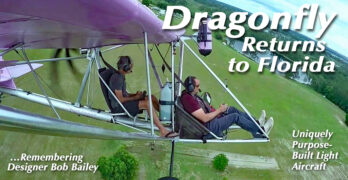Dragonfly was born in Florida in the early 1990s. Back-of-the-napkin sketches started in the 1980s following the dynamic 1970s when hang gliding swooped into national awareness. What one designer did with Dragonfly would become one of the most celebrated developments in hang gliding.
Throughout the ’70s, hang glider designs accelerated smartly in glide performance and sink rate, stretching from slope-hugging 4:1 triangular-shaped wings to elegantly long and slender “bladewings” that could exceed a 20:1 glide yet remain foot-launchable and still be an aircraft you could carry on your shoulder (when folded down). Passionate enthusiasts thrilled to a 5X performance improvement in a decade or so.
In the beginning, most pilots launched off mountains to get enough height to catch thermals. Yet lots of America doesn’t have mountainous terrain. Florida had plenty of pilots eager to fly hang gliders but to find the best soaring, they had to load up their gliders and drive 10-12 hours to the hills of Tennessee where flight park operators like me catered to them with mountain launch sites.
Affordable and Capable: Merlin Lite
sponsored by Aeromarine-LSA.com
sponsored by Aeromarine-LSA.com
News & Video on Light-Sport Aircraft, Sport Pilot Kits, and Ultralight Aircraft


